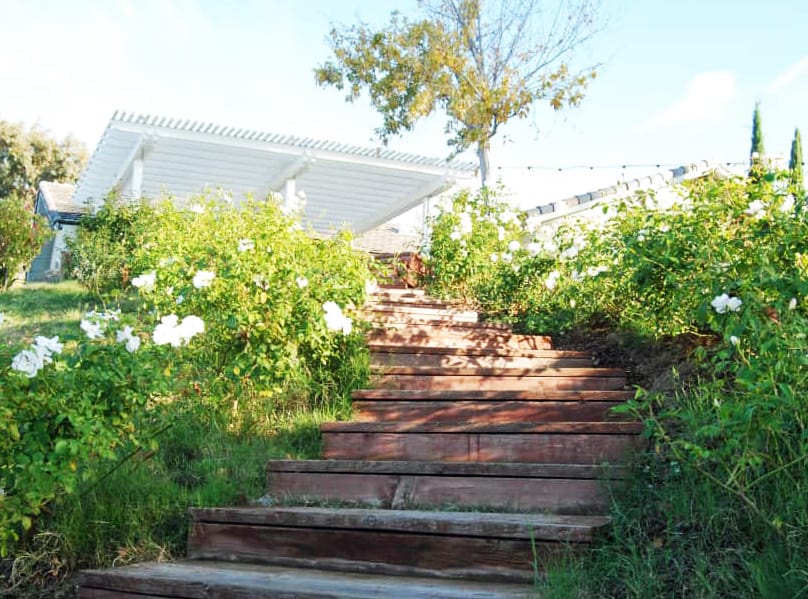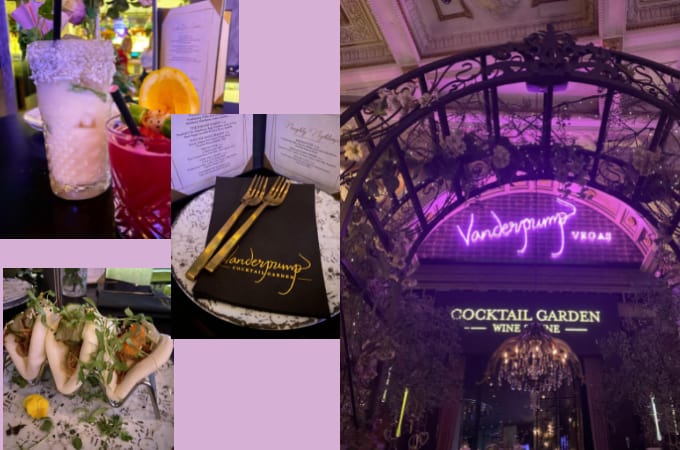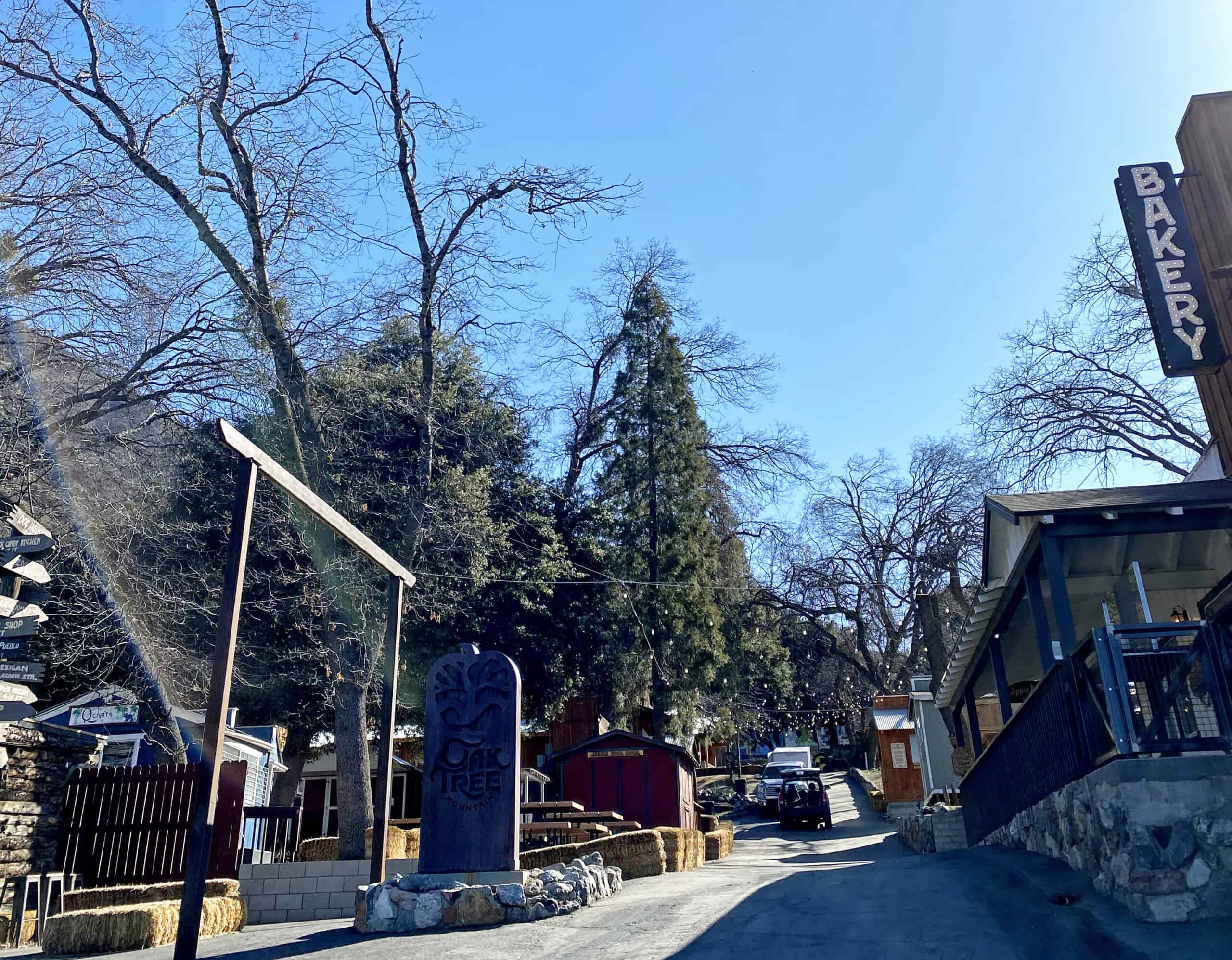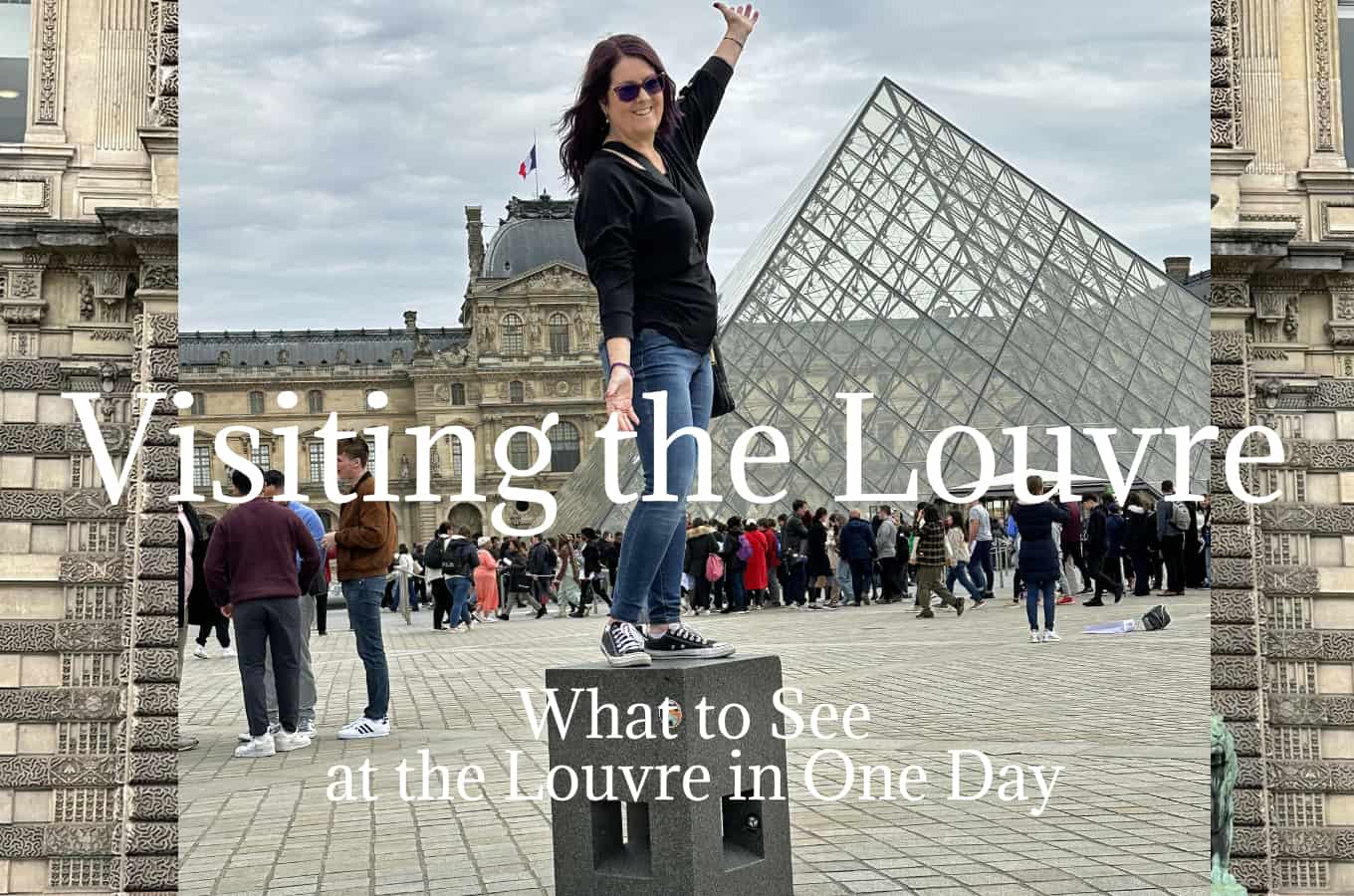What to See in Seven Days in Costa Rica: Best Travel Itinerary Ideas
If you’ve only got seven days in the gorgeous country of Costa Rica, with a little advanced planning and research, you can put together an amazing trip. Here are our best travel itinerary ideas for Costa Rica, specifically the Manuel Antonio area.
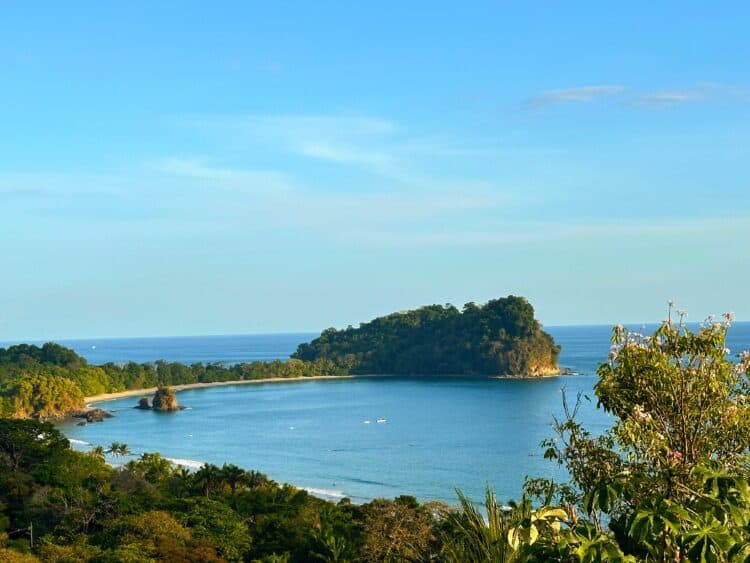
First, before I break down our Costa Rica travel itinerary suggestions, there are a few tips to keep in mind! These are some of the most-asked questions about traveling to Costa Rica.
- Rainy season in Costa Rica is May through November, with the worst months typically being September and October. Rain is more frequent in the afternoon/evening, and it will still remain hot throughout, but it can mean the closure of some activities. You’re best off doing tours, hikes, and any scheduled outdoor activities in the morning if possible. On a good side though — it’s less busy, and if you’re okay getting a little wet sometimes, you could have an absolutely amazing vacation with less crowds.
- Christmas in Costa Rica is beautiful, but it is also high tourist season.
- The tap water in Costa Rica is safe to drink. However, don’t swallow it when you’re at a waterfall, stream, lake, etc. Like anywhere that you travel, organisms/germs can live in the water. However, we did take our Larq water bottles with us; they are self-cleaning bottles where you push the top and it cleans out 99% of the organisms, including e-coli. This is great if you have concerns about cleanliness of the water. (Here is my Larq affiliate link if you want to look at them. We love ours!)
- If you are afraid of lizards, bugs, snakes, etc., you need to consider this when you’re booking your accommodations. Resorts typically don’t have an issue with them, but some AirBnBs or more desolate rentals may have some in and around your room. When we stayed at Hotel Costa Verde, we had only monkeys and birds visit our room, but there were several very large iguanas. They mostly leave you alone, but iguanas do like your food and may advance if they think they can sneak some.
- Unless you don’t want to leave your resort, you will need transportation. This can come in the form of a public bus (about $.65 USD one-way per person, you’ll need colones to pay as you board), a driver/shuttle (some hotels have shuttles, and some excursions will pick you up and return you) or a rental car. Rentals can range from cheap to expensive, but you will need AWD due to uneven terrain and bad weather.
- If you drive on your own around Costa Rica, install Waze on your phone. It’s a little more reliable in Costa Rica than Google maps. Keep in mind that roads are not well-lit at night, and many roads are narrow two-way roads with no sidewalks. People (thankfully) drive slower in Costa Rica than in the United States and other countries. There are also a decent amount of unpaved roads. During rainy season, some roads get washed out and/or flooded, which means you will have to turn around or replan your visit to a certain area. The country is not huge and there aren’t always a lot of road options, so pack your patience.
- It is pretty much hot in Costa Rica 24/7. It’s not unbearable, but if you have a health issue that could be exacerbated by heat and/or humidity, plan for accommodations that will allow you to stay safe and healthy. (I had a hard time with humidity once I got past 4-5 months pregnant, for example.) Not all rentals have air-conditioning, so check in advance.
- The exchange changes daily. Most places will take USD, so we exchanged only enough money into colones that we needed to ride the bus. We paid USD/cash for some of our excursions and tips, and used our international credit card for the rest; a credit card made for international travel avoids fees that regular credit cards may charge. IF you do use a regular credit card, it’s best to call them in advance so they don’t flag your card for possible fraud for sudden purchases out of country. (Ours cut us off while purchasing excursion tickets! We had to get them to remove the flag for the duration of our trip planning, and we hadn’t even left the country yet.)
- Big hospitals are only in the bigger areas of the country, such as Liberia and San Jose. I can’t give recommendations on health and/or travel insurance, but there are local urgent care centers in many of the regular cities like Quepos, which is minutes from Manuel Antonio. Pack adequate prescriptions and keep photos of your bottles on your phone in case of emergency.
- You do not need to speak Spanish for a short-term trip to Costa Rica. Most tourist areas and excursions have guides/staff that speak English, and we also heard some speaking other languages. However, if you know the basics at least, you’ll benefit because you can read signage and promotional paperwork a bit better.
- There are a lot of small stores all over Costa Rica, should you need things like bug spray, sunscreen, pain relievers, etc., but you won’t find big stores like Target outside of the San Jose/Liberia area. Hotels don’t often have shops like you may be used to, so if you take a car service from the airport to your hotel, you may benefit from having your driver stop at a store so you can pick up the basics for your room. Grocery stores usually have what you need, but you won’t necessarily see the brands you’re familiar with. Have a translator app on your phone if you can, so you can be sure you understand what it is you’re buying. Store staff are typically very kind and helpful though, so you can ask questions.
- Most of Costa Rica is a rainforest. There are two distinct sides of the country: Pacific side and the Caribbean side. Each of those sides has its own ecosystem and the oceans are different as well.
- On that very important note, my last tip: Costa Ricans, or Ticos, are amongst the most kind people we have ever met, and we’ve traveled significantly. They will go out of their way to help you, so be kind. We saw very little rudeness while we were in Costa Rica, and it was ALL from fellow Americans. Costa Rica is the place to leave the attitudes at home. We saw people act entitled and haughty, rude and impatient, treating staff as though they were beneath them. The Ticos were still polite and kind despite it all, handling it better than I would have.
What to See in 7 Days in Costa Rica: Our Best Travel Itinerary Ideas for Pura Vida in Manuel Antonio
Manuel Antonio is about a 3.5-4 hour drive from the San Jose Airport. (The drive from the Liberia Airport is longer, so we recommend SJO.) You can take a small hopper from SJO to the Quepos Airport, but the cost isn’t much more than a personal driver, and a driver will match your schedule instead of you having to wait on the next available flight; if you arrive at night, you won’t be able to get on a flight right away, and you still need a ride from the Quepos Airport to your hotel.
The drive is mostly a two-lane road (with a few turnouts/intersections) once you’re outside of San Jose itself, and there are potty stops; your driver should be fine with that if you need it. It’s not recommended to make it at night if you’ve never driven in Costa Rica yet. You will see some beautiful valley and jungle views along the way and you’ll go through the edge of Jaco along the coast.

Many of the hotels and resorts in Manuel Antonio are beach-facing, though there are some on the main roads. There are a lot of walkable beaches, though it will depend on where you stay. Costa Rica does not allow private ownership of beachfront property, so even if there is a hotel or resort on the beach, you are still able to visit it. Some hotels offer day passes for access through their stairs or property, and some even allow for pool use if you choose.
Everyone coming to Manuel Antonio Costa Rica needs to experience a few things:
- Animals
- Rainforest
- Beach
- Food
- Adventure
Start with GetYourGuide.com for great rates on reliable tours in and around Manuel Antonio!
These are obviously the same things you’ll want to experience in many other places in the country, so here are our recommendations on the best ways to experience them on a seven-day itinerary in Costa Rica!
Animals: The rainforest is full of animals, predominantly monkeys, birds, lizards/iguanas, and sloths. There are many others, too many to list, but these are the ones you’ll hear about the most. The best way to be almost guaranteed to see them is a tour of Manuel Antonio National Park. You can purchase tickets without a guide, but guides know where to find the animals, find some that hide which we will never see on our own, and most have a tripod monoscope for you to view through. (They will also provide photos they take through the scope to you after.)
If you go without a tour, you’ll see the guides gathering with their tour so you’ll get an idea of where to look, but you won’t be able to use the scope. The ticket for a guide is worth the extra money. Go in the morning for the best opportunity to see animal activity.
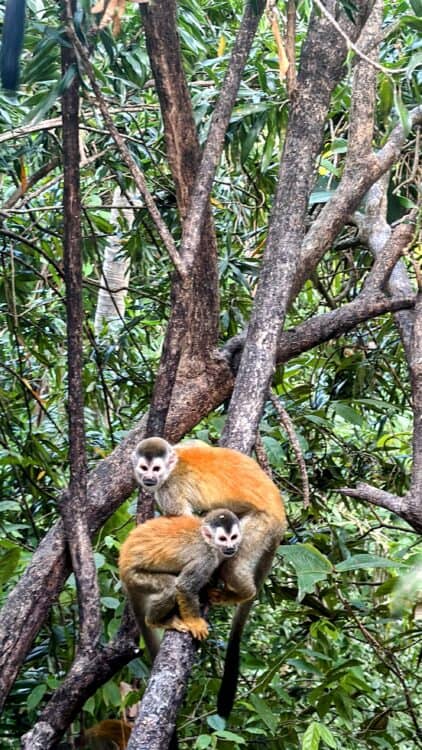
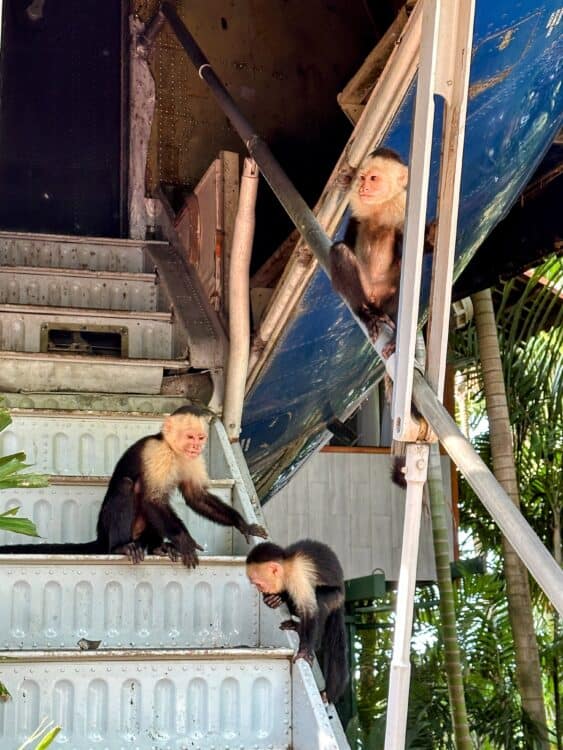
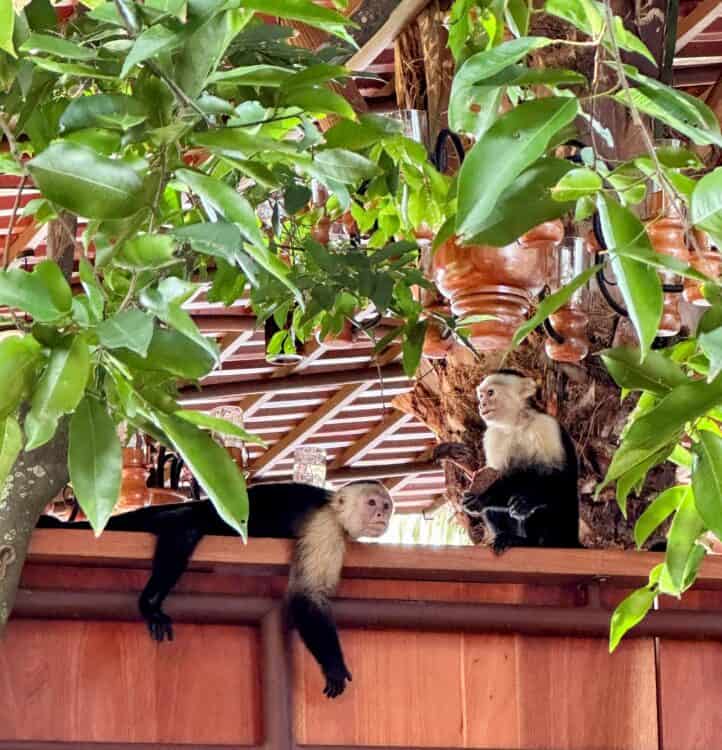
Some resorts have monkeys who practically live onsite, as the buildings are amongst the rainforest. We had monkeys on our balcony every morning at Hotel Costa Verde, several iguanas who lived by the pool, macaws in the surrounding trees, howler monkeys in the trees at night (they are not friendly monkeys and their shrieks can be disconcerting), and we’d see sloths by the pool and on the inner paths almost daily. Staff loves to show you where they are! Other hotels have monkeys but I think our hotel has the best opportunity to see them while you’re in the pool or just relaxing on your balcony.
Rainforest: It’s pretty much all of Manuel Antonio, so there are trees everywhere. It’s amazing to see all the greenery and hear the animals scattering about when you walk around. There are tours available of the national park at night, too, so you can see the nocturnal animals. (There are clothing requirements for night tours, so read the fine print.)
Beach: As I shared above, there are a lot of special inlets and coves available along the Pacific side of the main streets through town, but Manuel Antonio National Park also has a massive beach area where it’s in a cove so you can experience the beach but in a safer way. There are rip tides along the Pacific side, so be careful; even strong swimmers can get sucked in. The Buena Vista Hotel pathway leads to another open beach, where you don’t need to pay anything and the beach area is long and unhindered. Some areas require you to go down long steps or rocky areas so view your access points on a map. If you just want to laze around by the waves, you’ll have many, many options. (No car? This is where the public system comes in handy. It run about every 15 minutes, the signs are apparent and just like in Los Angeles or most anywhere else, you signal when you want to get off before the next step; you push a button on those buses, and they run from one end of Manuel Antonio to downtown Quepos at the bus station.)
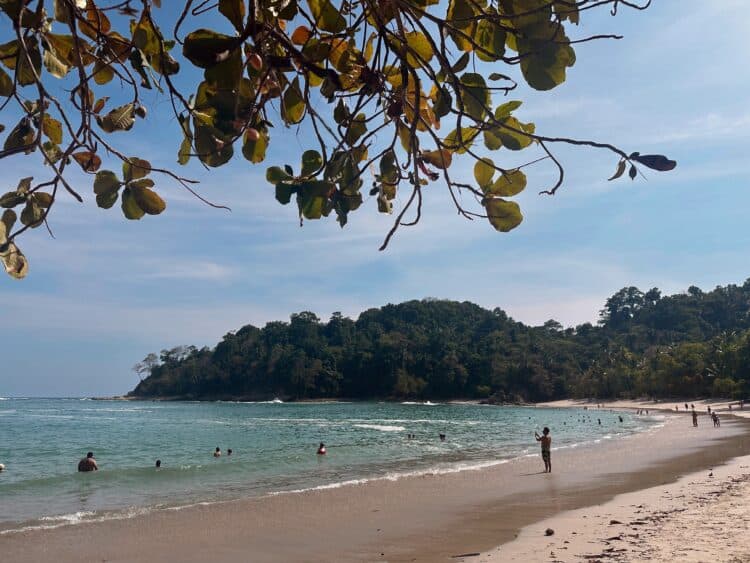


Some sections of the beach, like that just north of the national park, are the site of excursion bookings and rentals, so you can rent chairs and other things. There are also a lot of small restaurants and foodie pop-ups.
Food: This is my favorite one! You need to try a few of the mainstay authentic Costa Rican dishes, which focus on fresh produce, especially their amazing array of fruit. Gallo Pinto is the most common breakfast item, a rice and bean dish eaten with plantains and fruit. So good! Ceviche with patacones is another must-try, and chifrijo is something you will want to make at home after. There are too many restaurants in Manuel Antonio to mention them all, but here are a few I recommend:
- El Avion: It’s a Hotel Costa Verde restaurant that’s inside an old airplane from the Iran-Contra affairs time. (The hotel actually has six or seven onsite now, most used for unique, one-family lodging.) You can even get in the cockpit of the plane!
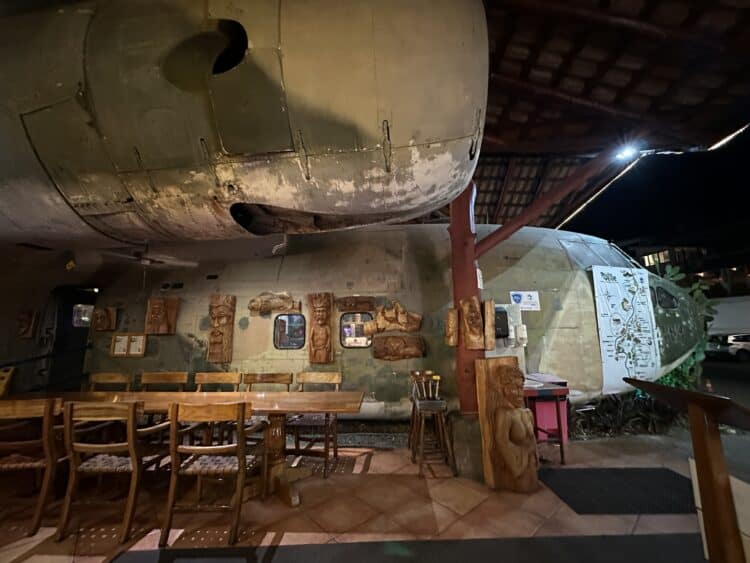

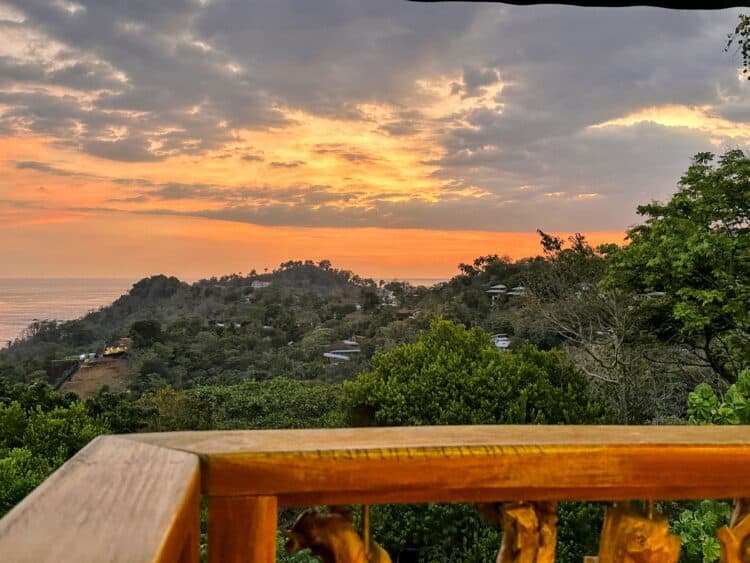
- Buena Vista: It’s a part of the Buena Vista Hotel, and doesn’t look like much outside, but the food is incredible and they put tables individually on the sand for you to eat, so you can have a candlelit dinner watching the sun go down. Their Guaro Sour is the best we had our entire trip, and that ceviche is a MUST. Our entire dinner, on our first visit (as we went back) included apps, two entrees, and four cocktails for under $100. (We’re from southern California, so this was cheap! In fact, we found most restaurants to be less than we’d pay at home, but some people will tell you it’s expensive, so it’s all subjective to what you’re used to.)
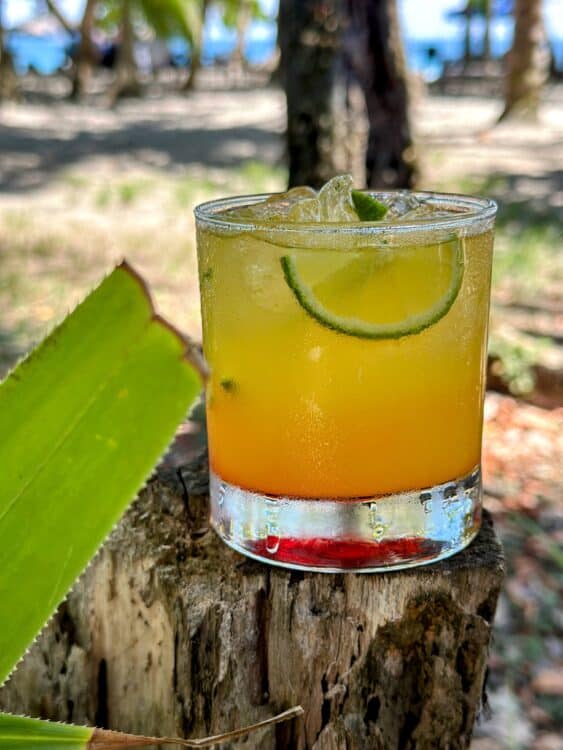
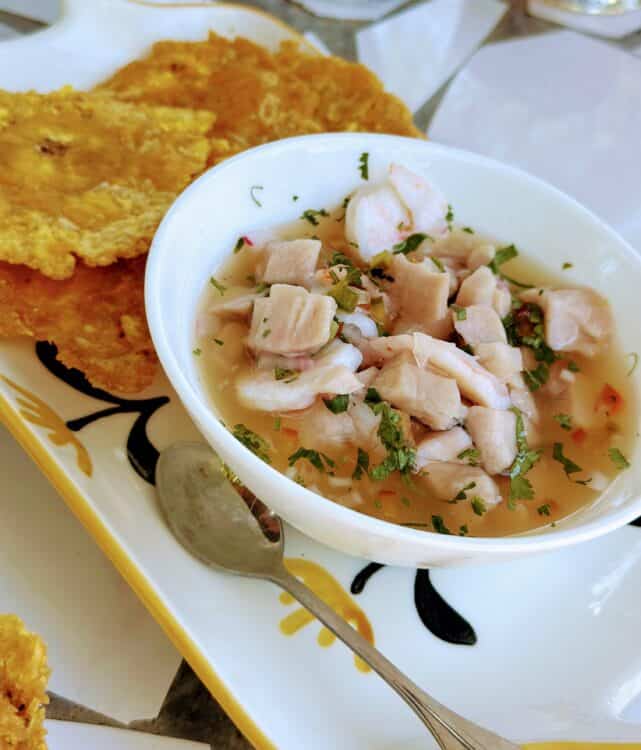
- Enzo Sushi: sushi with a Costa Rican spin! Nice views, not beachside, but only about a 15-minute walk from Hotel Costa Verde.
- Qui Si Sana: relatively new Italian restaurant, ocean view in the distance, small outdoor restaurant (but under cover) overlooking the hotel pool. Food was amazing, drinks were great (we tried a Costa Rican type of Aperol Spritz) and the chef is a young man not long out of culinary school who has put together a delicious and unique menu. This restaurant is down the stairs (outside) at a hotel, and the stairs go through these gorgeous purple lights and beautiful floral and fauna. (The only downer is that there was a party of young adults in the pool who were a little, uhm, frisky so we saw some speedos and backside cheeks while we were enjoying our wine. That’s probably not a nightly thing but I do wish the pool guests were a little more mindful that dinner guests may want a dinner vibe and not a frat party vibe.)
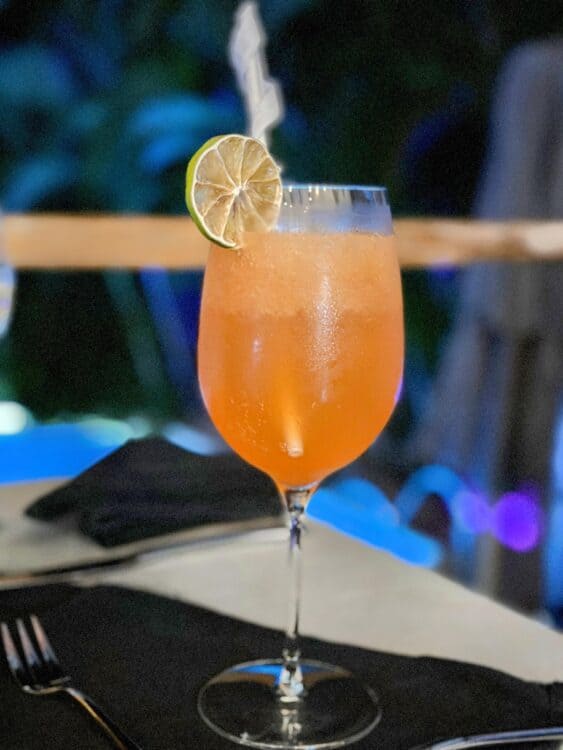

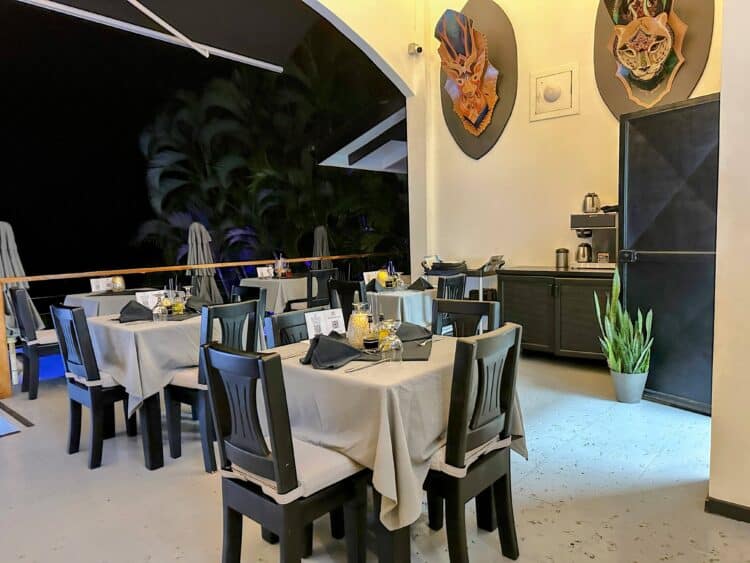
- La Cantina: directly across from the main entrance to Hotel Costa Verde, they have a varied menu, a killer cocktail list and live music nightly.
- Anaconda Cafe: traditional breakfast fare, fast service and what a view of the Manuel Antonio National Park “whale tail” peninsula! Best part though? Monkey entertainment almost every morning. They will steal your food if they get to your table, so be warned. It is an absolute joy to watch. Mommies, daddies, babies, they whole family will stare at you and run around. The best views are along the rails or the small patio off to the side that’s close to one of the airplane fusilage rooms. Their coffee is great too…but don’t miss the Chili Guaro shots. Think small, less tomato-y Bloody Mary. SO good. We did them every morning.
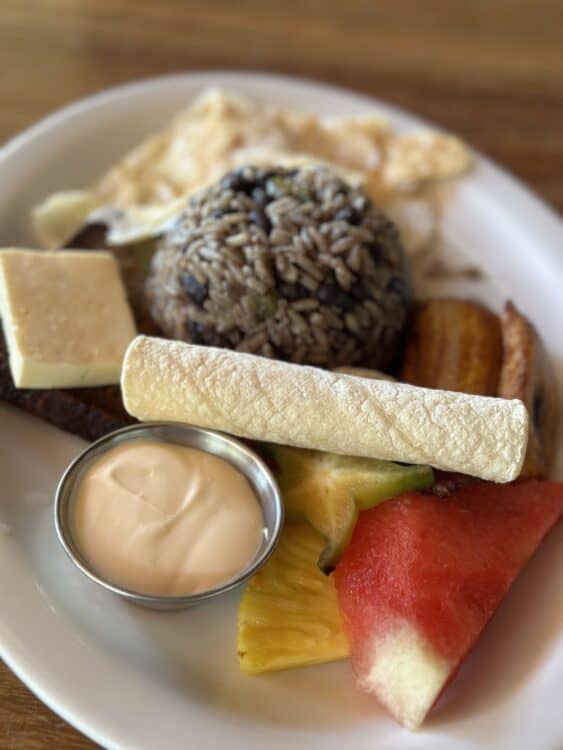
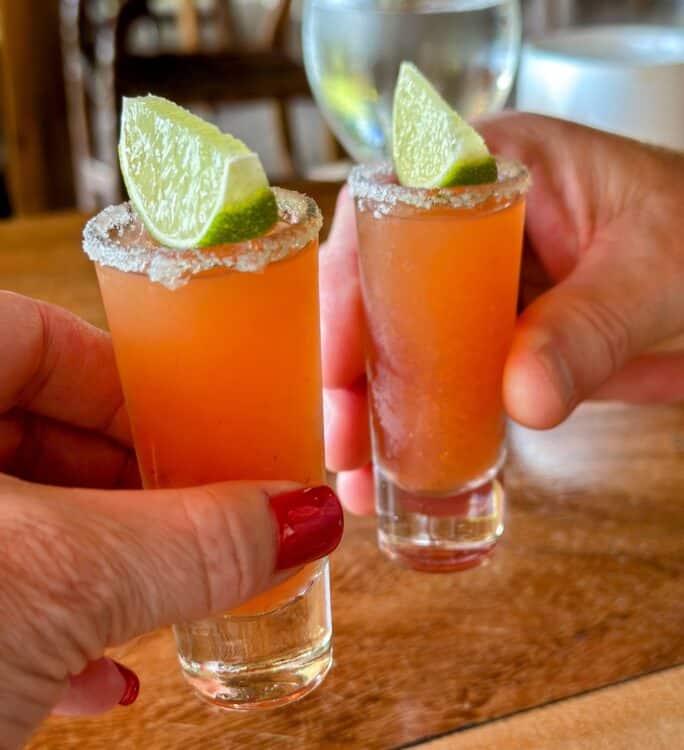
- Ronny’s Place: updated notes on this must-try restaurant! We visited this on our most recent Costa Rica vacation, and I’m so glad we were able to make it happen! We told them it was our wedding anniversary, and they seated us along the rails. What a view! Food was great, drinks were amazing, and that flaming banana dessert! It’s a show on its own and something you have to see to experience.
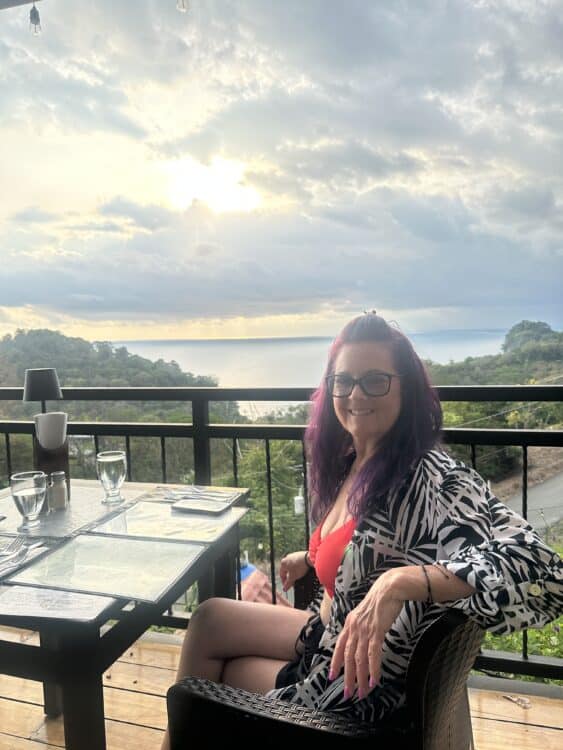
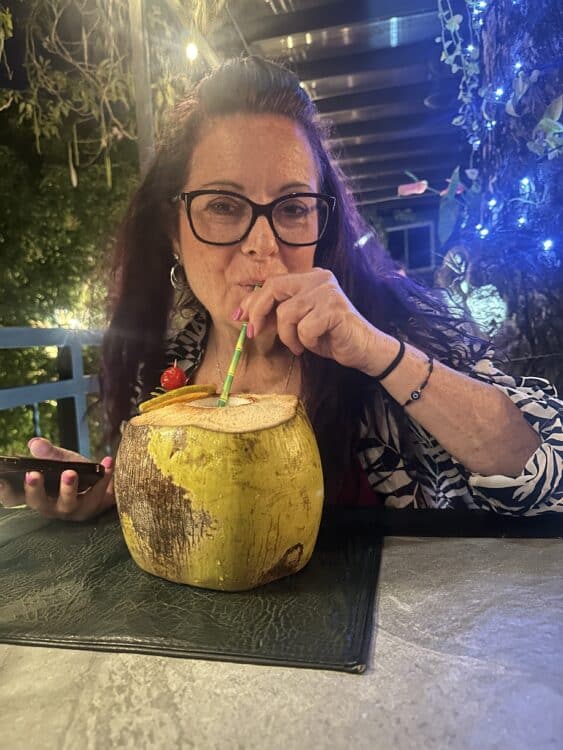


Last but very much not least, adventures. Costa Rica can be the best place to relax and enjoy the peaceful surroundings, but there are so many options if you want to get out and try new things. Coffee, chocolate, and vanilla bean tours are available if you’d rather not get too active; you can also hire a chef to teach you to cook, so if you’re not as mobile for whatever reason, you do have options, but Manuel Antonio has no end to active opportunities in nature to fill your seven days in Costa Rica. Here are a few we recommend:
- Parasailing: we saw this from our balcony and decided on day two to go for it. Our hotel concierge booked it for us, but it’s also available via the Manuel Antonio National Park website. (They have probably 50+ tours all over the Pacific side of Costa Rica.) They offer 15 or 30 minute tours, with a dual parasail or single. We paid $140 USD for a dual for 15 minutes. It takes off from the beach near the national park, and they provided transportation both ways. You will need water shoes as you land in the water, but you take off gently from the sand. (Take a waterproof phone lanyard if you want to take any videos or photos!) The cord extends about 400′-600′ so if you’re afraid of heights, you’re pretty up there. Gorgeous though and I’m glad we did it!
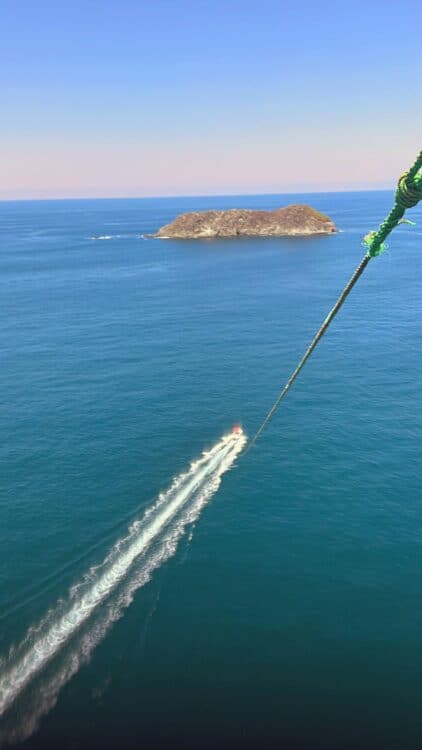
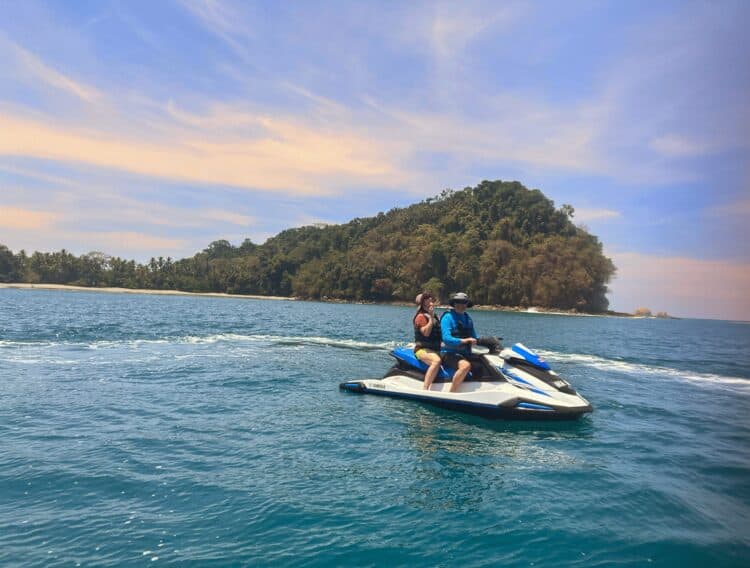
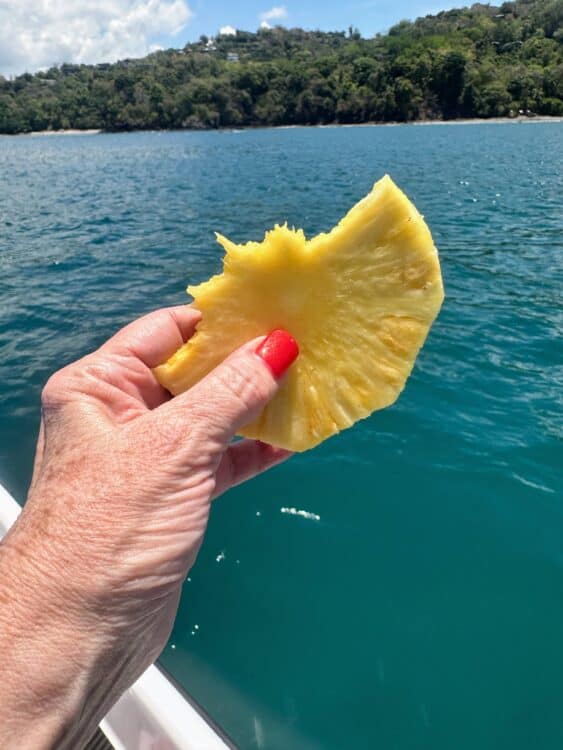
- Jet Ski Tour: also booked via our concierge and through the park, this takes off from the marina in Quepos and they provide transportation. We didn’t pay for a private tour, but we wanted one jet ski for the two of us and we ended up being the only people on the tour, so it was still private! Our guide was fantastic, laid out the very basic rules (such as follow him exactly, stay x feet behind, and a few arm signals so we could communicate) and we were good to go. I think this went about 90 minutes and it was a blast! He took us out pretty far at one point in the hopes of seeing a whale but all we saw was a sea turtle as it was not quite whale season, but very close. Highlight of this tour: he stops pretty far out in the cove of the park, we turn off the jet skis, and we eat fresh pineapple he brought! We also were able to get off the jet skis and get into the water. (He also joked that this is not only his office, but the bathroom…in case you’re worried about needing to go during the tour, as there’s no land during the tour.)
- Kayaking in the Mangroves: kayaking on small streams/rivers through mangroves where you can see monkeys and other animals
- Rainmaker Park: hanging bridges, hiking trails and beautiful scenery. Lots of heights involved, some much lower than others. Lots of spots to take in the views, and you can do this on your own or with a guide if you want a more private, guided experience.
- Horseback Riding: we did not do this one, but we spoke to some who did and they had good things to say about gentle horses on peaceful trails. One recommendation: check reviews, as some places treat their horses better than others.
- Ziplining: We chose Canopy Safari, but there are other options. We prefer this one for several reasons, including that it included transportation. It took us up into their mountains in an air-conditioned nice van (to an area we wouldn’t have otherwise seen), and the trail up to the top takes us on a wandering nature class, as the guides pointed out poisonous dart frogs, pepper plants, vanilla beans and more. The guides were patient and our group was just six of us. There were 11 zip lines, 2 rappelling opportunities, a hanging bridge and the Superman, where you are strapped in and do a zip line like Superman. And when it ends? You take a tour of a butterfly sanctuary, see some crocodiles, and are fed a delicious authentic Costa Rican meal made there onsite by two Tico chefs — all included with the price. If you have people in your party that cannot zipline, let them know that when you book as they can participate but on a different level.
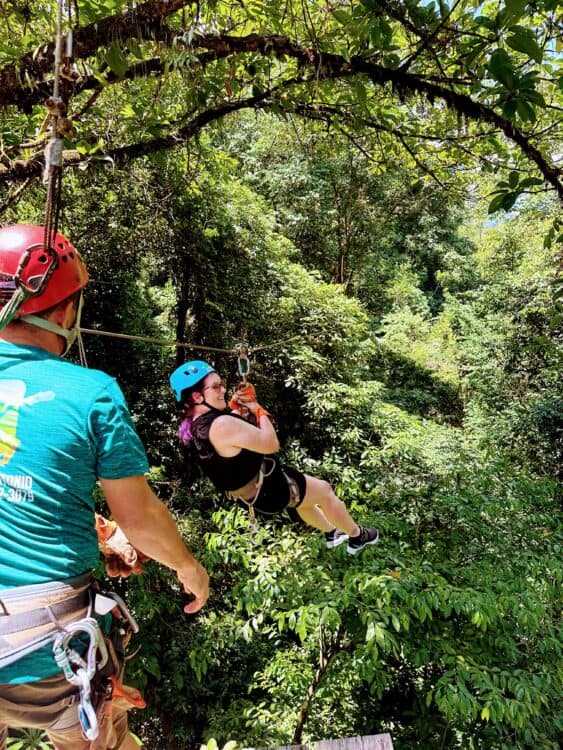

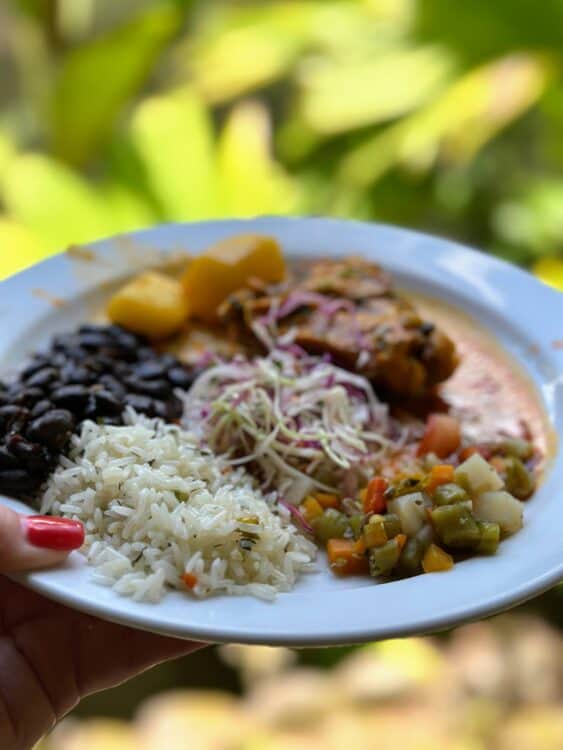
- There are also places to learn to surf, go deep-sea fishing (but you don’t get to keep the fish you catch), ride bikes and take extended waterfall hikes.
Your level of adventure is pretty much up to you! Most places will work with you as much as is possible to accommodate all the age ranges and abilities, so you can really craft a seven day itinerary that meets everyone’s needs and offers the proper mix of adventurous activity with relaxing pool- or beachside.
To plan your seven day itinerary in Costa Rica, I recommend you create an Excel or Google spreadsheet and mark days one and seven as travel days. Use rows to slot in your excursions, one per day, each morning. That will leave you time for lunch and dinner, and some shopping in downtown Quepos or Manuel Antonio outside the park, where there are some shops and restaurants. If you take the first slot of the day, you should be able to slot in another one later in the day, around midday or very early afternoon, and get in two per day. Don’t forget to slot in some pool time! We had some of the best times in the pool at Hotel Costa Verde, enjoying a strawberry daiquiri and a Pilsen, watching the sun set and the monkeys run around on the sails and ropes above our heads.
Days in Costa Rica start early. The sun rises around 5am, fishing boats head out around then, and things slow down once the sun sets around 6pm. Some businesses do stay open later, but you’ll see things really calm down outside of restaurants. Gift shops and boutiques are rarely open late. We adapted to the time change very quickly, getting up each day at 5:15am when the monkeys started traveling over the pool to the other side of the resort. We’d have dinner around 6pm nightly, and when we got back to the hotel, we’d go over our next day’s activities, plan our outfits, pack our bag if needed, and watch some tv before falling asleep.
Last tip: WhatsApp is used very heavily in Costa Rica. It’s how most companies will communicate with you for tickets, pickups, etc. It’s free and only requires WiFi. Be sure to create your account in advance though, you only need your own phone number to set it up.
However you spend your 7 days in Costa Rica, do all the things you can! Pura vida!


